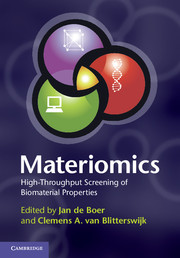Book contents
- Frontmatter
- Contents
- List of contributors
- Preface
- Chapter 1 Introducing materiomics
- Chapter 2 Physico-chemical material properties and analysis techniques relevant in high-throughput biomaterials research
- Chapter 3 Materiomics using synthetic materials: metals, cements, covalent polymers and supramolecular systems
- Chapter 4 Microfabrication techniques in materiomics
- Chapter 5 Bioassay development
- Chapter 6 High-content imaging
- Chapter 7 Computational analysis of high-throughput material screens
- Chapter 8 Upscaling of high-throughput material platforms in two and three dimensions
- Chapter 9 Development of materials for regenerative medicine: from clinical need to clinical application
- Chapter 10 Non-biomedical applications of materiomics
- Chapter 11 Beyond bed and bench
- Index
- References
Chapter 10 - Non-biomedical applications of materiomics
Published online by Cambridge University Press: 05 April 2013
- Frontmatter
- Contents
- List of contributors
- Preface
- Chapter 1 Introducing materiomics
- Chapter 2 Physico-chemical material properties and analysis techniques relevant in high-throughput biomaterials research
- Chapter 3 Materiomics using synthetic materials: metals, cements, covalent polymers and supramolecular systems
- Chapter 4 Microfabrication techniques in materiomics
- Chapter 5 Bioassay development
- Chapter 6 High-content imaging
- Chapter 7 Computational analysis of high-throughput material screens
- Chapter 8 Upscaling of high-throughput material platforms in two and three dimensions
- Chapter 9 Development of materials for regenerative medicine: from clinical need to clinical application
- Chapter 10 Non-biomedical applications of materiomics
- Chapter 11 Beyond bed and bench
- Index
- References
Summary
Scope
Materiomics approaches may be applied broadly in the design and characterization of a wide range of materials, going beyond the biomedical focus. This chapter presents essential concepts relevant to the implementation of materiomics to physical and chemical properties not usually associated with biomedical materials. Recent progress in this area is reviewed briefly with several examples given in high-throughput measurement of organic and inorganic materials properties. The applications that are covered range from speciality coatings to membranes for fuel cells and metal–organic framework materials for carbon capture. Properties treated here include mechanical, spectroscopic and transport characteristics.
Tutorial on basic principles
Materials complexity
While previous chapters have focused on the application of materiomics concepts to biomedical materials, this chapter will emphasize how and why materiomics is being employed in materials research and development beyond the biomaterials field. The central challenge inherent to materials research and development is that most products consist of multiple components whose final properties are usually a sensitive function of composition and processing conditions. The complex interactions make it difficult, if not impossible, to design products a priori without significant experimentation. Academicians are often interested in characterizing fundamental phenomena, such as phase transitions or magnetization, and discovering how these phenomena can be used to develop novel materials functionalities.
- Type
- Chapter
- Information
- MateriomicsHigh-Throughput Screening of Biomaterial Properties, pp. 177 - 198Publisher: Cambridge University PressPrint publication year: 2013



